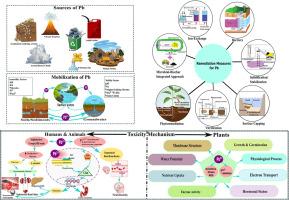全球土壤、沉积物和水环境中的铅污染:暴露、毒性和修复
引用次数: 0
摘要
铅(Pb)是一种重金属(loid),由于其高延展性,低熔点,耐腐蚀性和与其他金属结合的能力,历史上被用于油漆,珠宝,电子,焊接,管道和炊具。然而,铅被认为是土壤、沉积物和天然水中常见的有毒元素之一。目的与方法本文综述了铅污染的现状,重点介绍了铅污染的分布、持久性、命运及其对人类和植物的影响。我们调查了最近的文献,重点是:(a)土壤、沉积物和水环境中铅污染的来源;(b)铅的迁移、发生、毒性机制及其潜在的健康影响;(c)土壤和水中铅污染的各种修复方法。此外,还讨论了美国、中国和印度在不同生态系统中铅来源和污染的案例研究。结果:1)全球许多土壤、沉积物和水中的铅浓度都超过了允许的限度,而修复工作在很大程度上仍然是局部的,规模有限。2) Pb的迁移性促进了它的生物积累,使其能够替代Ca 2 +在植物和动物中作为信号信使。这会导致不良影响,如植物发芽和营养吸收受损,以及对人类和动物的神经毒性和其他级联负面影响。结论土壤、沉积物和水环境中存在中度至重度铅污染,需要进一步研究其迁移和毒性。因此,应全面研究这种污染物,并通过适当的政策干预加以缓解。本文章由计算机程序翻译,如有差异,请以英文原文为准。

Global lead contamination in soils, sediments, and aqueous environments: Exposure, toxicity, and remediation
Background
Lead (Pb) is a heavy meta(loid) and historically been used in paints, jewelleries, electronics, soldering, plumbing, and cookware due to its high malleability, low melting point, resistance to corrosion, and ability to bond with other metals. However, Pb is recognized as one of the toxic elements commonly occurring in soils, sediments, and natural water.
Objectives and methods
This article provides a comprehensive review of the current status of Pb contamination, underscoring its distribution, persistence, fate, and impacts on humans and plants. We investigated recent literature focusing on: (a) sources of Pb contamination in soils, sediments, and aqueous environments, (b) lead mobilization, occurrences, toxicity mechanisms, and their potential health effects; and (c) various remediation methods for Pb contamination in soil and water. Additionally, case studies from the USA, China, and India on Pb sources and pollution in different ecosystems are discussed.
Results
Our findings indicate that: 1) Lead concentrations exceed permissible limits in numerous soils, sediments, and water globally, while remediation efforts remain largely localized and limited in scale. 2) The mobility of Pb facilitates its bioaccumulation, enabling it to substitute for Ca²⁺ as a signalling messenger in plants and animals. This results in adverse effects such as impaired germination and nutrient uptake in plants, as well as neurotoxicity and other cascading negative impacts in humans and animals.
Conclusion
The study reveals that soils, sediments, and aqueous environments are moderately to highly polluted with Pb, necessitating further investigation into its mobilization and toxicity. Therefore, this contaminant should be comprehensively studied and mitigated through appropriate policy interventions.
求助全文
通过发布文献求助,成功后即可免费获取论文全文。
去求助
来源期刊

Journal of trace elements and minerals
Medicine and Dentistry (General), Analytical Chemistry, Environmental Science (General), Toxicology, Biochemistry, Genetics and Molecular Biology (General), Nutrition, Veterinary Science and Veterinary Medicine (General)
自引率
0.00%
发文量
0
审稿时长
65 days
 求助内容:
求助内容: 应助结果提醒方式:
应助结果提醒方式:


